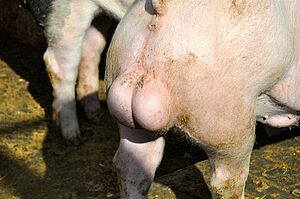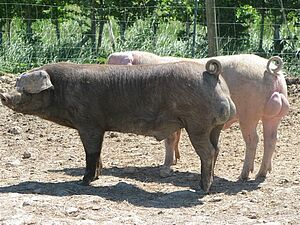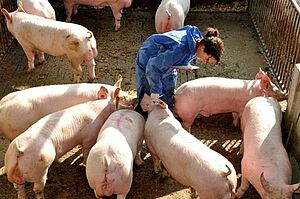Castrating male piglets is a controversial topic that has generated a lot of discussion among farmers, animal rights activists and politicians. Castration under anaesthesia and/or analgesia is already an important improvement. However, a more interesting and animal-friendly alternative is boar fattening.
Most male piglets are castrated shortly after birth, because from the moment of sexual maturity at about 5 months, their meat starts to contain increased amounts of androstenone and skatole. These are the main components of the typical boar taint. This odour is created when heating up the meat, more specifically the fat, and not everybody detects it. Moreover, not every boar "smells." Depending on research, the method of evaluation and carcass weight, the affected percentage lies between 1 and 35 percent (Malmfors und Lundström, 1983; Marty, 2011; Holinger et al., 2015).
Due to their sex hormones, boars are more aggressive than their castrated counterparts and show increased sexual behaviour (Cronin et al., 2003; Holinger et al., 2015). This may lead to more unrest in the groups and a possible decrease in animal welfare. However, the fattening of boars does have its advantages: No working hours are put into the castration process, the feed conversion of the boars improves, and the boars’ carcasses contain more lean meat (Xue et al., 1997). In comparison to other methods like castration - with or without anaesthesia - or immunocastration, boar fattening is definitely the most animal-friendly method; in other words, it is perfect for organic agriculture.
The task is to find ways to reduce the boar taint through breeding, feeding and housing while detecting carcasses with a noticeable smell and making appropriate use of them. Research in conventional pig husbandry has generated a lot of knowledge on boar fattening. There are, however, some significant differences between organic and conventional boar fattening, like feeding, space allowance, occupational material and - in parts - fattening period. Boar fattening under organic conditions is possibly even more difficult to implement. That is why it is important for researchers to deal with the topic in depth and to offer further solutions to the producers soon.
Status quo in Europe
In December 2010, 18 associations from EU-agriculture and food processing as well as animal rights groups agreed to refrain from castrating male piglets and signed the so-called European Declaration (anonymous, 2010). This agreement is voluntary but receives support from the European Commission and the participants need to comply with several requirements before implementation. For example, methods to detect smell or recommendations on husbandry, transport and slaughter of boars must be provided.
Boar fattening is nothing revolutionary; especially in Ireland, the UK and Portugal, it is common to leave the boars intact. There is also a long tradition of boar fattening in Southern European countries and of raw meat products, like the famous air-dried hams that do not smell without being heated. Moreover, there are obvious differences in perceiving and assessing boar taint between consumers in different countries. In the UK, for instance, the tolerance to androstenone is higher than in other countries (Blanch et al., 2012).
In Germany, some producers are pushing towards boar fattening: in May 2012, three big slaughterhouses guaranteed that they would accept boars. However, castration without anaesthesia is still allowed in conventional pig fattening until late 2018. Organic certification organizations have different procedures: producers associated with "Bioland" are required to perform the castrations under analgesia or anaesthesia. "Naturland" adherents are required to use narcotics and/or analgesia. In Austria, both the "Association of Austrian Pig Farmers" and "Bio Austria" have voluntarily committed to using analgesia. In Switzerland, castration in general (conventional and organic) is only allowed under anaesthesia and analgesia. This was implemented in 2010. Livestock owners are allowed to use a device for anaesthesia via inhalation of isoflurane, after they have completed a course. Distribution of isoflurane to livestock owners in Germany and Austria is not allowed. This is one of the reasons why anaesthesia via inhalation is more common in Switzerland than in other countries
Reducing boar taint through breeding
Heritability of androstenone and skatole in fat mass is relatively high: depending on the study, heritability for androstenone is estimated to be around 0.6 whereas, for skatole, it is estimated to be around 0.4 (Frieden et al., 2011). Some breeding associations in Germany and Switzerland already offer animal sperm, which is supposed to create offspring with less boar taint.
However, even currently used breeds show significant differences in forming the two components responsible for boar taint. While only about 5 to 8 percent of Hampshire or landrace boars show increased levels of androstenone, Duroc boars reach about 50 percent (Squires, 2006). Considering boar taint, it is better when the animals are ready for slaughter as soon as possible - especially before reaching sexual maturity. Age seems to be a more significant factor than weight (Zamaratskaia et al., 2005). Slowly growing, more robust breeds might be disadvantaged. Organic farms mostly use conventional genetics, but through restrictions on feeding components, feeding cannot be done as intensively as on conventional farms.
Influence of feeding
Feeding can influence the skatole levels in boar fat. Skatole is formed in the digestive track from the amino acid tryptophan. Boars have higher levels of skatole in their fat because their body cannot break it down as well as females or castrated males (Doran et al., 2002). Certain feedstuff can influence the production of skatole. In several studies, researchers examined the effect of raw potato starch, chicory roots or Jerusalem artichokes (Jensen und Hansen, 2006; Vhile et al., 2012; Zamaratskaia et al., 2005).
In order to make full use of the boars’ feed conversion and potential, the feedstuff has to contain high levels of protein, especially lysine, as practice trials have shown (Meyer, 2011). Since certain amino acids are not easily obtained in organic agriculture, this could turn out to be another obstacle to overcome.
Husbandry
Boars are more active and aggressive than barrows or sows, which has consequences on the husbandry of the animals. They often display mounting behaviour, which leads to more injuries, especially lameness. However, aggressiveness and susceptibility to injuries decreases towards the end of the fattening period until, with a live weight of 115 kilos they behave no differently from barrows or sows (Rydhmer et al., 2006). Organic pig farming is supposedly suitable to boars because the lower ranking animals have the possibility to use the extended space as a retreat in case of conflicts. The offer of manipulable material or access to pastures can be an advantage because it provides a distraction.
In terms of group compilations, it became clear that there should be as little regrouping as possible (Fredriksen et al., 2006). The ideal case would be sibling groups living together from weaning until slaughter. In sibling groups, boars even produce less androstenone. The explanation for this is probably a delayed puberty (Fredriksen et al., 2008). However, sibling groups are not a practical solution because of their size and weight differences.
It is a very controversial question if boars and sows should be kept together or separately. Hence, FiBL conducted a field test in 2012 and 2013 that was supposed to show which group combination was suited best for organic conditions. Even though the boars showed similar behaviour with or without sows, the boars in boar groups had more injuries on their skin (Holinger et al. 2013; Holinger et al., 2015). However, the injuries were only skin-deep and no deep wounds, as other authors described. No pregnancies were detected among the sows. The group combinations did not influence boar taint or its components androstenone and skatole. The possibility of specific feeding is one factor in favour of gender-separate feeding.
Here you find a video on the project (German).
Sorting out, processing raw or mixing
The biggest challenge in boar fattening is probably to safely identify the boar taint on the evisceration line. Trying to find an electronic nose seems to prove unsuccessful, because the boar taint is seemingly too complex. In today’s German slaughterhouses, there are trained specialists who quickly have a smell of the heated fat samples of the carcasses and decide whether there is taint or not (Marty, 2011). Another challenge is the processing of the tainted carcasses. Thanks to the capacity of these companies, they can be processed into raw food products separately. There are no samples or smell tests in the UK and Spain. Instead, the meat is sold or processed in its entirety (Stoll, 2002). Tainted meat is often mixed with non-tainted meat in processed food. For small processing factories, it is harder to operate a separate line of processing.








